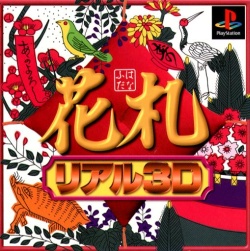Hanafuda are playing cards of Japanese origin, used to play a number of games. The name literally translates as 'flower cards'.
There are twelve suits, representing months. Each is designated a flower, and each suit has four cards. Typically, there are two 'normal' cards worth one point, one poetry ribbon card worth five points, and a final special card worth ten or twenty points. The point values could be considered unnecessary and arbitrary, as the most popular games only concern themselves with certain combinations of taken cards.
Koi-Koi Gameplay:
The object of the game is to form special card combinations called 'yaku' from cards accumulated in your point pile. You can gain cards in your point pile by matching cards in your hand, or drawn from the draw pile, with cards on the table. Once you have made a yaku, you can stop to cash in your points, or keep going (referred to as 'koi-koi,' hence the name of the game) to form additional yaku for more points.
An initial dealer (called the 'oya', or 'parent'), is decided upon when the game starts. This can be done with any method (rock-paper-scissors, dice roll) the players agree upon. A hanafuda-specific method involves random card draw: each player draws a single card; the player who draws a card from the earliest month is the oya.
To deal, the oya deals eight cards to his opponent (face down), the table (face up), then to himself (face down), though this is normally done two or four cards at a time. The rest of the cards are set aside as a draw pile, and then play begins starting with the oya.
On a player's turn, he may match by suit (i.e. month or flower) any one card in his hand with one on the table, and take both into his point pile. Alternatively, he may discard any one card from his hand face up to the table (which is his only choice if he can not match anything). Having done this, he then draws one card from the draw pile. If this card matches any card now on the table, he must match that card and keep both for his point pile; otherwise, he must discard it face up to the table. In the event that the drawn card matches more than one card on the table, the player gets the choice as to which card to match and therefore keep in addition to the drawn card.
After a player's turn ends, if he made at least one yaku that turn, that player must then make a choice. He may stop play and gain all the points he is entitled to from the yaku he has, or he can choose for play to continue (calling 'koi-koi') in an effort to gain more points.
Should he koi-koi and gain another yaku, his points are doubled. He may continue making this choice so long as he keeps gaining yaku; each time he calls koi-koi, the multiplier for his score increases by one. However, if his opponent gains a yaku before him, his opponent now makes this decision. The score multiplier applies to him as well, and should he decide to end the hand, he gains his points while the other player gains none.
In essence, each time koi-koi is called, the current hand's score multiplier is increased by one - the first time it is called, any points gained are doubled; the second and they are tripled, and so forth. Furthermore, once a player gains a yaku, he gets the choice to call the hand or koi-koi. Only the player who calls the hand gains points; regardless of how many yaku a player may have, if he did not end the hand, he gains no points.
The winner of the hand becomes the new oya, and assuming both players agree, a new hand is dealt. Should both players ever run out of cards to play, without having formed a yaku on the last play, no points are awarded to either player, and the next hand begins with the same oya.
Some groups, when gambling, will require the player whose score was multiplied to pay a proportionately larger amount of the winnings (i.e. a player who continued play twice would pay twice as much as the other player, since his score would have been doubled).
Hanafuda Real 3D is a 3d simulation game that features all the hanafuda rules and features different game modes, like tournamente in which the player have to defeat 5 different computer characters and arcade mode in which the player have to compete until the points reachs zero.
Manufacturer's description:
A classic card game software that you can enjoy plenty of powerfully with 3D graphics images. The card is large and easy to see, realistic feeling is outstanding with 3D directing such as turning bills! Includes familiar "Kokoi" and "Oi chokabu". In mode, there are two "winning mode" to fight with individual character rich five characters, and "arcade mode" which can fight back until the point of ownership becomes zero.
Features:
- First person perspective.
- 3D graphics
- Cartoon graphics
- Hanafuda theme.
|
|

